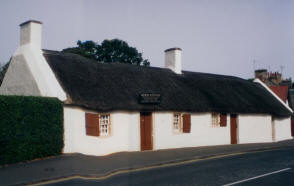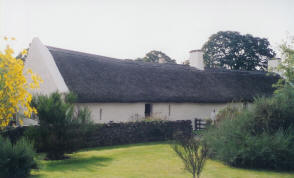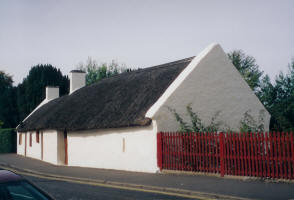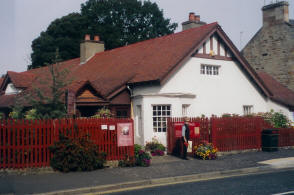The Life of Robert Burns
By Frank R. Shaw, FSA Scot
Part I
 Introduction:
Nearly a year ago I was asked by the editor of “An
Biodag”,
Meredith Shaw, to write a series of articles on the life of
Robert Burns for this very noteworthy Clan Shaw newsletter. We
agreed on four articles, one per quarterly issue, which would
take a year to work through. The articles have taken on a life
of their own and have become a series based more on the
education, poetry and songs of Burns rather than on his life in
general or the chronological events in his life. This wee series
is in keeping with the theme Robert
Burns Lives!
that we started a few years ago. Our goal was for the column to
“bring insights into Burns” - that it would be “a layman’s “Introduction
to Robert Burns 101”,
and it would be “a teaching column” for the man in the streets,
not necessarily for the Burns scholar. I have taken a rather
non-scholarly, non-classroom approach in writing these articles
on Burns. This is the first of the four articles that appeared
or will appear in “An Biodag”
(“The Dagger”).
Introduction:
Nearly a year ago I was asked by the editor of “An
Biodag”,
Meredith Shaw, to write a series of articles on the life of
Robert Burns for this very noteworthy Clan Shaw newsletter. We
agreed on four articles, one per quarterly issue, which would
take a year to work through. The articles have taken on a life
of their own and have become a series based more on the
education, poetry and songs of Burns rather than on his life in
general or the chronological events in his life. This wee series
is in keeping with the theme Robert
Burns Lives!
that we started a few years ago. Our goal was for the column to
“bring insights into Burns” - that it would be “a layman’s “Introduction
to Robert Burns 101”,
and it would be “a teaching column” for the man in the streets,
not necessarily for the Burns scholar. I have taken a rather
non-scholarly, non-classroom approach in writing these articles
on Burns. This is the first of the four articles that appeared
or will appear in “An Biodag”
(“The Dagger”).
 Like many of us, Robert Burns was born into a
family that had difficulty making ends meet. The Burns family
would, in today’s language, be below the poverty threshold. Once
in a letter, he proudly proclaimed: “I was born a very poor
man’s son”. They were what many in the South refer to as “dirt
farmers”. The year of his birth was 1759, (January 25), a date
now celebrated all over the world as people gather to pay
tribute to their Scottish Bard, eat haggis, neeps and tatties,
and toast Burns with words, whisky and wine on Burns Night.
Like many of us, Robert Burns was born into a
family that had difficulty making ends meet. The Burns family
would, in today’s language, be below the poverty threshold. Once
in a letter, he proudly proclaimed: “I was born a very poor
man’s son”. They were what many in the South refer to as “dirt
farmers”. The year of his birth was 1759, (January 25), a date
now celebrated all over the world as people gather to pay
tribute to their Scottish Bard, eat haggis, neeps and tatties,
and toast Burns with words, whisky and wine on Burns Night.
Burns was taught old Scottish songs by his
mother, Agnes Brown, and he learned stories from his mother’s
cousin, Betty Davidson, who “was remarkable for her ignorance,
credulity and superstition”. The influence of these two women
can be found throughout his writings. William Burnes, Robert’s
father, saw to it that Robert and his brother Gilbert attended a
small school in their town and was instrumental in hiring, along
with some neighbors, one John Murdoch to teach their children
the Bible and other literature to prepare them for life. This
was a big step for Robert and his fellow classmates, and the
Burns boys ranked near the head of their class, “even when
ranged with boys by far their senior”.
Later, when Murdoch moved away, William Burnes
spent his evenings instructing the boys. Their education
continued in the village of Dalrymple, and later Robert spent
several weeks with his old mentor Murdoch learning as much
English as possible, as well as an introduction to French. He
had the opportunity to study surveying one summer in Kirkoswald.
There he found he made infinitely more progress in “the
knowledge of mankind”, culminating in “swaggering riot and
roaring dissipation”. The 16-year-old boy learned to “mix
without fear in a drunken squabble”. By now, considering his
station in life, Burns was considered a well-educated young man.
Ironically, as we look back on their education,
Murdoch found that “Robert’s ear, in particular, was remarkably
dull, and his voice untunable…” and that Gilbert possessed “a
more lively imagination, and to be more of a wit”. Little did
Murdoch know that Robert would become a master of poetry, prose,
and song, forever to be Scotland’s Bard, and his followers to
this day “never tire of telling you that Burns has been
translated into more languages than any poet writing in English,
including a lad named William Shakespeare…”
 From farm to
farm, almost like nomadic farmers or “share-croppers” as we
called such people in the little Pee Dee area of South Carolina,
William Burnes moved his family, his goal being to keep them all
together. This proud man did not want his children to be “little
underlings” in other people’s homes. By the time Burnes rented a
farm in Mount Oliphant, which according to Gilbert were 70 acres
of the poorest soil imaginable, William had four children.
From farm to
farm, almost like nomadic farmers or “share-croppers” as we
called such people in the little Pee Dee area of South Carolina,
William Burnes moved his family, his goal being to keep them all
together. This proud man did not want his children to be “little
underlings” in other people’s homes. By the time Burnes rented a
farm in Mount Oliphant, which according to Gilbert were 70 acres
of the poorest soil imaginable, William had four children.
Working in
the fields with Nellie Kilpatrick, “a bonie, sweet, sonsie lass
of thirteen”, Robert at 14 wondered why his pulse quickened
“when I looked and fingered over her hand, to pick out the
nettle stings and thistles”. Learning that the words of Nellie’s
favorite song were written by a country laird’s son, Robert knew
he could write better lyrics, and it was here that Robert “first
committed the sin of RHYME”.
O once I lov’d a bonie lass,
An’ aye I love her still!
An’ whilst that virtue warms my breast
I’ll love my handsome Nell.
During these early years Robert worked on the
farm and at the age of 15 “became the farm’s principal
labourer”. Doing a man’s work in a child’s body, Burns scholars
insist the “strain of these years led to the rheumatic heart
condition that resulted in the poet’s premature death’ at the
age of 37. Again, not too much can be said about the poverty and
hardship that dominated the Burns family. They were indeed dirt
farmers and were dirt poor, as evidenced by the fact that
Gilbert wrote: “We lived sparingly. For several years butcher’s
meat was a stranger in the house…”
 A few years later, wanting to give “my manners a
brush”, Burns defied his father and enrolled in a country
dancing school. He wanted more in life than walking behind a
horse, and he helped establish a debating society, the
Tarlbolton Bachelor’s Club, limited to 16 members, all
bachelors. Each bachelor had to be a “professed lover of one or
more of the female sex”. If your goal was to make a lot of
money, you were not eligible for membership. Neither could you
be mean-spirited. This young man who was becoming more and more
a rebel wore his hair differently - his was the only tied hair
in the parish. This is not the only time Burns rebelled against
society, church, and the rich. Part II will take us into the
early manhood of Robert Burns. (FRS: 8-25-05)
A few years later, wanting to give “my manners a
brush”, Burns defied his father and enrolled in a country
dancing school. He wanted more in life than walking behind a
horse, and he helped establish a debating society, the
Tarlbolton Bachelor’s Club, limited to 16 members, all
bachelors. Each bachelor had to be a “professed lover of one or
more of the female sex”. If your goal was to make a lot of
money, you were not eligible for membership. Neither could you
be mean-spirited. This young man who was becoming more and more
a rebel wore his hair differently - his was the only tied hair
in the parish. This is not the only time Burns rebelled against
society, church, and the rich. Part II will take us into the
early manhood of Robert Burns. (FRS: 8-25-05)
Sources:
A Biography of
Robert Burns,
James Mackay
An Appreciation
for Robert Burns,
Sir James Fergusson
Robert Burns, A
Life,
Hugh Douglas
Robert Burns,
David Daiches
Robert Burns,
The Tinder Heart,
Hugh Douglas
Robert Burns,
A Pitkin Guide
Robert Burns’
Scotland,
J. A. Carruth
The Ranting Dog, The Life of Burns,
John Lindsey

